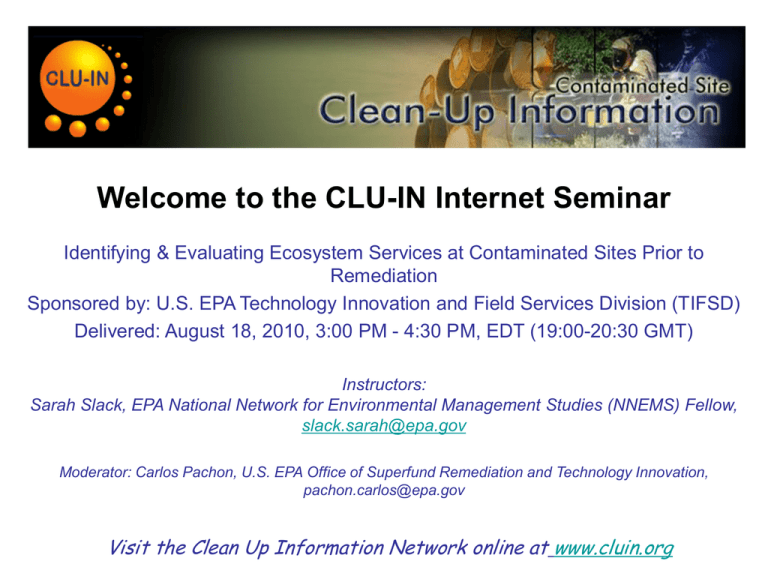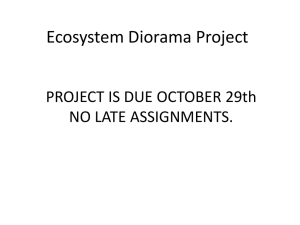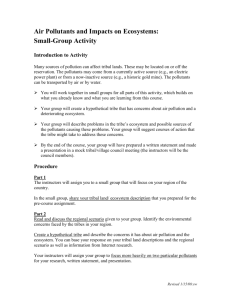Identification & Evaluation of Ecosystem Services at - CLU-IN
advertisement

Welcome to the CLU-IN Internet Seminar Identifying & Evaluating Ecosystem Services at Contaminated Sites Prior to Remediation Sponsored by: U.S. EPA Technology Innovation and Field Services Division (TIFSD) Delivered: August 18, 2010, 3:00 PM - 4:30 PM, EDT (19:00-20:30 GMT) Instructors: Sarah Slack, EPA National Network for Environmental Management Studies (NNEMS) Fellow, slack.sarah@epa.gov Moderator: Carlos Pachon, U.S. EPA Office of Superfund Remediation and Technology Innovation, pachon.carlos@epa.gov Visit the Clean Up Information Network online at www.cluin.org Housekeeping • Please mute your phone lines, Do NOT put this call on hold – press *6 to mute #6 to unmute your lines at anytime • Q&A • Turn off any pop-up blockers • Move through slides using # links on left or buttons Download slides as PPT or PDF Go to slide 1 Move back 1 slide Move forward 1 slide Go to last slide Go to seminar homepage Submit comment or question Report technical problems • This event is being recorded • Archives accessed for free http://cluin.org/live/archive/ Identification & Evaluation of Ecosystem Services at Contaminated Sites Sarah Slack NNEMS Fellow US EPA 3 Purpose Raise awareness of ecosystem services in the context of contaminated site cleanup Discuss options for the creation of a replicable methodology to evaluate ecosystem services Alternatives to mitigate impacts & maximize the provision of ecosystem services 4 Green Remediation The practice of considering all environmental effects of remedy implementation and incorporating options to minimize the environmental footprints of cleanup actions. http://clu-in.org/greenremediation 5 Ecosystem Services The benefits human populations derive from ecosystems. 6 Millennium Ecosystem Assessment Regulating Services: Supporting Services: • Climate regulation • Disturbance regulation • Water regulation • Waste treatment • Nutrient cycling • Pollination • Soil formation • Habitat Provisioning Services: Cultural Services: • Food production • Raw materials • Genetic resources • Medicinal resources • Recreation • Aesthetics • Existence • Science / Education 7 Final Ecosystem Services Disturbance regulation Water supply Food production Raw materials Genetic & medicinal resources Cultural services Climate regulation Erosion control & sediment retention Waste treatment Habitat (with a few exceptions) 8 Impacts on Ecosystem Services NPL Sites Proposed Sites 9 Ecosystem Services Assessment Prior to and throughout the remediation process Reuse & revitalization Cleanup protectiveness 10 Service Identification Marine Coastal Wetlands Inland Water Forest & Woodlands Grasslands & Drylands Mountain Urban Climate regulation Disturbance regulation Erosion control Waste treatment Habitat Water supply Food production Raw materials Genetic resources Medicinal resources 11 Set Site Priorities All Ecosystem Services Services at Site Site Priorities 12 Things to Consider… Scarcity Vulnerability Reversibility Substitutes 13 Other Methods Community Involvement & Economic Valuation Method Background Benefits transfer Uses estimations of benefits obtained from a service in one context, to estimate values of service in a different context or site. Choice modeling A survey approach in which respondents are asked to choose their preferred option for a set of alternative scenarios. Contingent valuation Hypothetical scenarios are posed to the public which involve some valuation of alternatives. They are responses are elicited based on their willingness to pay for each alternative scenario. Travel cost For society to utilize a service, it may require travel. The service is valued based on society's willingness to pay to utilize the resource. Replacement cost Services may be replaced by a manufactured product or physical structure. The cost to produce this manmade substitute, represents the value of the service provided. Avoided cost When services are functioning properly, it allows society to avoid certain costs. The service is valued based on this cost. Factor income Values services based on their impact and enhancement of salaries. For example, commercial fisheries will have an increased catch and therefore income when there are available services such as fish habitat and clean water. Hedonic pricing The value of a service is derived from its presence / effect on market-priced goods. For example, aesthetic values can be derived from the real estate market by comparing similar properties with and without good views. Conjoint evaluation The public is asked to make choices between alternative scenarios with different attributes and prices, in order to derive the marginal value of a service instead of the total value. 14 Identify Impacts 15 How do we mitigate impacts? 16 Practices to Minimize Ecological Damage Work zone & traffic plans Minimize excavation & retain existing vegetation Phase site work Avoid introducing new sources of contamination Location of contaminated waste & soil Develop & communicate ecological awareness 17 Models Indicators Data Collection GIS Local or indigenous knowledge 18 Potential Data Sources ERAs & NRDAs 19 Issues & Concerns Ecosystems are complex systems Varying temporal & geographic scales 20 Issues & Concerns Continued Data sources Community involvement Economic valuation 21 Rocky Mountain Arsenal… wildlife refuge chemical weapons manufacturing facility 22 In the future… 23 Online Resources http://clu-in.org/greenremediation 24 Thank You! Sarah Slack slack.sarah@epa.gov NNEMS Fellow, US EPA After 09/2010: sarahaslack@gmail.com pachon.carlos@epa.gov 25 Resources & Feedback • To view a complete list of resources for this seminar, please visit the Additional Resources • Please complete the Feedback Form to help ensure events like this are offered in the future Need confirmation of your participation today? Fill out the feedback form and check box for confirmation email.









